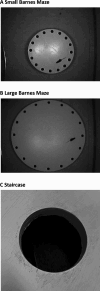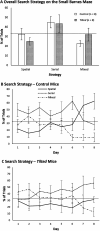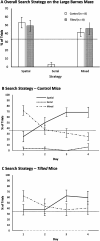Task demands influence search strategy selection in otoconia-deficient mice
- PMID: 40356633
- PMCID: PMC12066313
- DOI: 10.3389/fneur.2025.1531705
Task demands influence search strategy selection in otoconia-deficient mice
Erratum in
-
Corrigendum: Task demands influence search strategy selection in otoconia-deficient mice.Front Neurol. 2025 May 16;16:1621211. doi: 10.3389/fneur.2025.1621211. eCollection 2025. Front Neurol. 2025. PMID: 40452764 Free PMC article.
Abstract
Introduction: The vestibular system plays a crucial role in visual and non-visual navigation. Our recent study found that signals from the otolith organs are necessary for mice's use of distal visual cues to guide navigation to an invisible goal. Somewhat surprisingly, however, performance was not significantly impaired on some spatial tasks (e.g., Barnes maze reference memory task), questioning the role of otolith signals in visual navigation.
Methods: We report the results of several additional tests of reference memory performance and search strategy use on two versions of the Barnes maze, in an attempt to establish further understanding of the otolithic contribution to visual navigation.
Results: On a small Barnes maze, control mice preferentially used the efficient "spatial" search strategy by the last (8th) day of training, whereas otoconia-deficient tilted mice failed to show this preference. On the subsequent probe trial, both groups showed a preference for the former goal location, suggesting otolith signals are not necessary for the use of distal cues to triangulate the animal's position, relative to distal cues. On a large Barnes maze, both control and tilted mice used a spatial search strategy most frequently by the last (4th) day of training and showed a preference for the former goal location on the subsequent probe trial.
Discussion: Overall, these results suggest that otolith dysfunction in mice is associated with subtle navigational deficits that became apparent on the small maze but that were less apparent on the large maze. It is possible that these navigational differences resulted from the greater distance between start and goal locations of the large maze, relative to the small maze. Alternatively, the large maze's greater distance between the goal and potential alternatives may have facilitated more accurate place recognition.
Keywords: Barnes maze; otolith organs; reference memory; self-movement; spatial.
Copyright © 2025 Yoder, Carstensen and Jagannathan.
Conflict of interest statement
The authors declare that the research was conducted in the absence of any commercial or financial relationships that could be construed as a potential conflict of interest.
Figures







References
-
- Benhamou S, Sauvé J-P, Bovet P. Spatial memory in large scale movements: efficiency and limitation of the egocentric coding process. J Theor Biol. (1990) 145:1–12. doi: 10.1016/S0022-5193(05)80531-4 - DOI
-
- Mittelstaedt ML, Mittelstaedt H. Homing by path integration in a mammal. Naturwissenschaften. (1980) 67:566–7. doi: 10.1007/BF00450672 - DOI
Grants and funding
LinkOut - more resources
Full Text Sources

